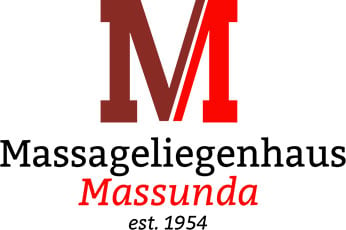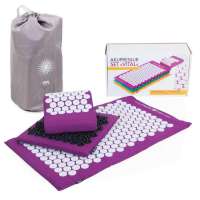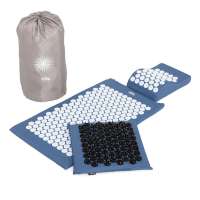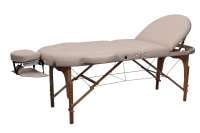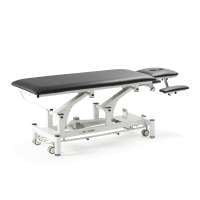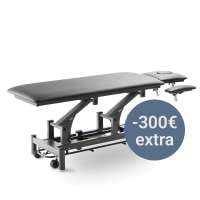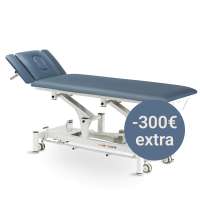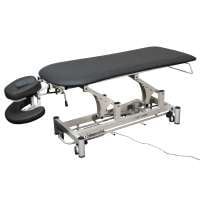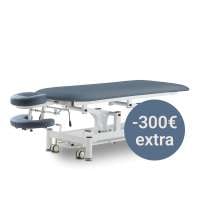
Back pain is a widespread health issue that affects people of all ages. It can occur both acutely and chronically, significantly impairing quality of life. The back is a complex structure consisting of vertebrae, muscles, ligaments, and nerves, playing a crucial role in body stabilization and mobility. When back pain occurs, it can lead to limitations in daily activities and hinder the ability to perform certain tasks.
According to studies, approximately 80% of people experience back pain at least once in their lifetime. It is one of the most common causes of disability and a primary reason for doctor visits.
In this blog article, we will explore:
-
What causes back pain?
-
What are the types of back pain?
-
How can I relieve back pain?
-
How can I prevent back pain?
1. What causes back pain?
The causes of back pain are diverse and can range from individual factors to external influences. Muscular tension and injuries are common triggers for acute back pain. However, conditions such as herniated discs, spinal issues like scoliosis or arthritis, as well as obesity and lack of exercise, can cause or worsen back pain. Even psychological stress and strain can impact the back and lead to pain.
a. Muscular Tension and Injuries
Muscular tension can arise from various factors such as overexertion, poor posture, prolonged sitting, or physical activities. When the muscles in the back are overloaded or injured, they can become tense and cause pain. This pain often manifests as a dull, pulling discomfort and can occur both acutely and chronically.
b. Herniated Discs
The intervertebral discs located between the vertebrae of the spine serve as shock absorbers and cushions. They consist of an outer fibrous ring and a soft, gel-like core. A herniated disc occurs when the outer fibrous ring becomes damaged or weakened, causing the inner core to protrude outward. This can compress the nerve roots within the spinal canal or in the area where the nerve root exits. Herniated discs can result from aging, wear and tear, injuries, or overexertion. The pain can be localized to the affected area or radiate to other regions of the body such as the legs or arms.
c. Spinal Issues Like Scoliosis or Arthritis
Scoliosis is an abnormal sideways curvature of the spine, while arthritis refers to joint inflammation. Both conditions can lead to chronic back pain. With scoliosis, the spine is not correctly aligned, resulting in structural imbalances. This can cause muscle imbalances, uneven distribution of load, and pain. Arthritis, on the other hand, can affect the joints of the spine and cause inflammation. This inflammation leads to pain, stiffness, and restricted mobility.
d. Poor Posture and Ergonomic Issues
When we adopt poor posture, it compromises the natural alignment and stability of the spine. This can result in excessive strain on specific areas of the back, particularly the lower back. An example of this is prolonged sitting with a rounded back in front of a computer. Ergonomic issues, such as an unsuitable workstation or improper seating position, can also contribute to increased back strain.
e. Obesity and Lack of Exercise
Obesity and lack of exercise are two interconnected causes of back pain. Excess weight places additional stress on the spine and the muscles in the back. The extra weight increases pressure on the spinal discs, muscles, and ligaments, which can lead to pain and discomfort.
Moreover, a lack of regular physical activity can weaken the muscles in the back. However, the back muscles play a vital role in stabilizing the spine and maintaining a healthy posture. When these muscles are weakened, the risk of experiencing back pain increases.
f. Psychological Stress and Strain
Stress can lead to increased muscle tension, especially in the back and neck area. When we are stressed, we tend to raise our shoulders and tense our backs, which can result in muscle tension and pain. Furthermore, psychological burdens such as anxiety and depression can amplify the perception of pain and decrease pain tolerance.

2. What are the types of back pain?
Back pain can be classified into different types depending on their duration, cause, and specificity. In this section, we will explore the various types of back pain and provide further details on their characteristics.
a. Acute Back Pain
Acute back pain refers to sudden onset pain in the back that typically lasts less than three months. It can be caused by an acute injury, excessive strain, improper movement, or sudden, unfamiliar activities. An example of acute back pain is the sudden occurrence of severe pain after lifting a heavy object or engaging in an unusual physical exertion.
The symptoms of acute back pain can vary, but they often manifest as stabbing, sharp, or dull pain in the back area. The pain can be localized or radiate along the spine. In most cases, acute back pain can be managed with rest, pain medication, and targeted exercises to strengthen the back muscles. Most people recover from acute back pain within a few weeks or months.
b. Chronic Back Pain
Chronic back pain refers to pain that lasts longer than three months or is recurring. It may have an underlying cause or stem from an untreated or improperly treated acute back condition. Chronic back pain can significantly impact daily life and restrict quality of life.
The causes of chronic back pain can be diverse, ranging from degenerative spine conditions to muscle weakness and inflammatory conditions. It is important to identify the exact cause of chronic back pain in order to initiate appropriate treatment.
The treatment of chronic back pain typically involves a combination of pain management, physical therapy, exercise therapy, and possibly psychotherapeutic support.
c. Specific Back Pain (e.g., Herniated Disc)
Specific back pain refers to pain with a specific cause, such as a herniated disc. A herniated disc occurs when the soft inner core of an intervertebral disc protrudes through a weakened outer fibrous ring, potentially compressing nerves and causing pain. Specific back pain often requires targeted treatment approaches tailored to the underlying cause.
Other examples of specific back pain can include spinal fractures, spinal stenosis, spondylolisthesis (vertebral slippage), or inflammatory conditions like ankylosing spondylitis. These specific back pains often require an accurate diagnosis through medical imaging or other diagnostic procedures to identify the cause. The treatment of specific back pain depends on the underlying cause and may involve conservative therapy, medication, physiotherapy, or, in some cases, surgical interventions.
d. Non-Specific Back Pain
Non-specific back pain refers to pain in the back where no clear structural or anatomical cause can be identified. It accounts for the majority of back pain cases. The exact reasons for non-specific back pain are often challenging to determine as they can be multifactorial. Factors such as muscle tension, poor posture, psychosocial stress, obesity, and lack of exercise can contribute to non-specific back pain.
The treatment of non-specific back pain usually focuses on relieving pain, restoring functionality, and implementing preventive measures to avoid future back problems. This can involve a combination of pain medication, physiotherapy, targeted exercises to strengthen the back muscles, postural improvements, stress management, and a healthy lifestyle.
3. How Can I Alleviate Back Pain?
Here are some tips and strategies that can help reduce back pain in everyday life.
-
Heat and cold therapy: Heat and cold applications can be effective in alleviating back pain. Heat, such as warm towels or heating pads, improves blood circulation, relaxes muscles, and relieves pain. Cold treatments, such as cold packs or ice packs, can reduce inflammation and decrease swelling. It is advisable to apply heat or cold therapy for about 15-20 minutes and repeat regularly.
-
Spinal decompression: Maintaining the proper sleeping position and using an appropriate mattress can help relieve pressure on the spine and reduce back pain. It is recommended to sleep on a mattress that is neither too firm nor too soft and provides sufficient support. An ergonomic sleeping position, where the spine remains in a neutral alignment, can also be helpful. Placing a pillow under the knees when lying on the back or sleeping on the side with a pillow between the knees can alleviate spinal pressure.
-
Stress reduction and relaxation techniques: Psychological stress can have a negative impact on the back and worsen existing back pain. Therefore, it is important to reduce stress and incorporate relaxation techniques into daily life. Regular breaks, deep breathing exercises, meditation, yoga, or other relaxation techniques can be beneficial. By taking time for relaxation and stress reduction, muscle tension in the back can be reduced, and pain can be alleviated.
-
Ergonomic aids and back supports: Using ergonomic aids in the workplace or at home can help promote a healthy posture and prevent back pain. For example, ergonomic chairs, desk accessories, or back supports can relieve the spine and support proper alignment.
-
Stretching and relaxation exercises for the back: Regular stretching and relaxation exercises for the back can improve flexibility and release muscle tension. There are various exercises such as cat-camel stretch, back extensions, side stretches, and shoulder rolls that can loosen the back and reduce pain. It is important to perform these exercises slowly and regularly to maximize their effectiveness.

4. How Can I Prevent Back Pain?
Back pain can not only be burdensome in everyday life but also have long-term effects on quality of life. Fortunately, there are various measures that can be taken to prevent back pain.
a. Make Sure Your Workplace is Ergonomic
An ergonomic workplace setup is of great importance in preventing back pain. Proper desk and chair height, an ergonomic keyboard and mouse, and an appropriate screen height can support a healthy posture. In addition, taking regular breaks to avoid prolonged sitting and relieve the muscles is important.
b. Learn How to Lift Heavy Objects Properly
Maintaining correct posture is crucial for protecting the back. Whether standing, sitting, or walking, an upright posture with a straight back and relaxed shoulders is recommended. When lifting heavy objects, it's important to bend the knees, keep the back straight, and carry the load close to the body to avoid excessive pressure on the spine.
c. Exercise Regularly
Regular physical activity and targeted exercise can help strengthen the muscles and stabilize the spine. Endurance sports such as swimming, cycling, or jogging, as well as exercises to strengthen the core and back muscles, are particularly recommended. It's important to gradually increase activities and pay attention to the individual abilities and needs of one's own body.
d. Manage Your Weight
Excess weight can exert additional pressure on the spine and contribute to back pain. A healthy diet and regular physical activity can help achieve and maintain a healthy body weight. By reducing excess weight, the burden on the spine can be reduced, and the risk of back pain can be decreased.
e. Use Relaxation Techniques
Stress can have a negative impact on the back and lead to muscle tension. Therefore, it's important to incorporate stress management techniques into daily life. This can be achieved through regular breaks, deep breathing exercises, meditation, yoga, or other relaxation techniques. By reducing stress and promoting relaxation, muscle tension in the back can be prevented.
How did you like the article?
With your feedback, we can improve our content.
❤️ Very interesting! - ☺️ Okay. - ☹️ Not interesting.

